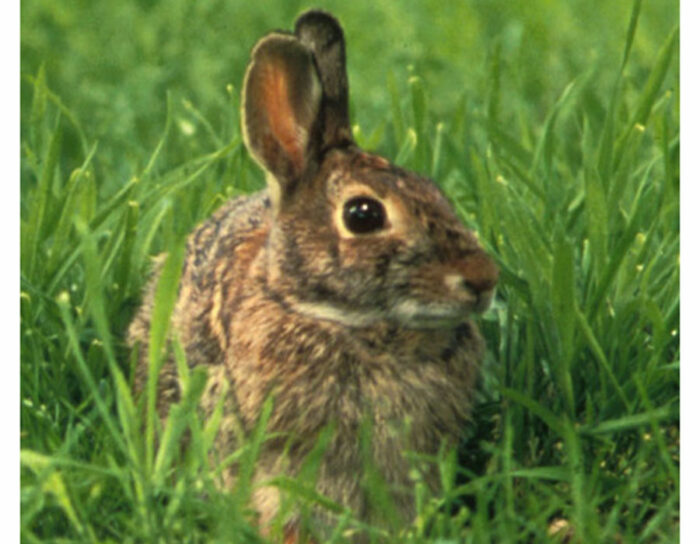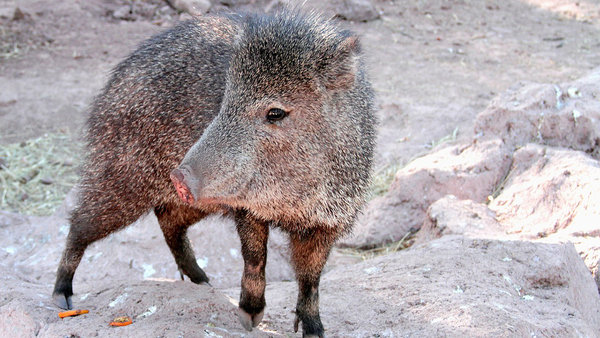
When Beatrix Potter’s Mrs. Rabbit warned Peter not to go into Mr. McGregor’s garden, the admonition went in one of Peter’s large ears and out the other. And so it goes today. Vegetable gardens, orchards, and ornamental plants are highly attractive to rabbits, especially during droughts and long winters or where urbanization has reduced their wildland habitat.
Learn more: Keep Rabbits Out Of Your Fall Garden
A childhood perspective on rabbits as mischievous but benign cuddly animals usually fails to prepare adults for their first encounter with wild rabbits running amok among their prized cabbages. The distraught gardener is left furious about the damage but dreading the idea of harming those undeniably cute rabbits.
Fortunately, there are practical ways to outwit the wild rabbits without doing them harm.
Know your rabbit and its ways
There are two groups of wild rabbits that can become problems in the garden: jackrabbits (Lepus spp., a type of hare) and cottontails (Sylvilagus spp., a true rabbit). The blacktailed jackrabbit, the most common species, is a mottled brownish-gray with a black strip extending along the tail to the rump. It weighs 4 to 8 pounds and is 19 inches long, with 4- to 7-inch-long ears, short front legs, and long hind legs. Cottontail rabbits are smaller in size than jackrabbits and hares. The Eastern cottontail, the most widespread species, averages 12 inches in length and weighs 2 to 4 pounds. Its fur appears gray or brownish-gray. Its ears are smaller than those of jackrabbits, and its hind feet are much larger than its forefeet. Its short white tail resembles a cottonball—hence its common name.
Biology and behavior. Rabbits do not have a long life span. Jackrabbits average five to six years, and cottontails live about two years in the wild. But they make the most of it by producing two to six litters per year, each litter yielding two to eight young rabbits. Unlike the European rabbit, neither jackrabbits nor cottontails dig burrows. Jackrabbits prefer the wide open spaces where they nest in natural depressions in the ground. This choice appears related to the fact that they run at a rate of 30 mph and leap 20 feet in a single bound to escape predators such as coyotes, snakes, hawks, and human hunters. Cottontails are slower and prefer to nest in a more protected environment, such as brushy fence rows, debris-filled gullies, or landscaped back yards.
The most humane method for protecting your plants from foraging rabbits is to exclude their access to the plants.
Where food and cover are plentiful, rabbits tend to stay put. Cottontails can live their entire lives within a 3- to 10-acre area; jackrabbits may forage within only a 2-mile roundtrip from their nesting site. This characteristic combined with their frequent reproduction enables rabbits to quickly fill any empty habitat created when other rabbits are trapped and removed. That is why fencing gardens when you’re in rabbit country is so important.
Food preferences. Rabbits feed morning and evening throughout the year, primarily on grass. Jackrabbits consume up to 1 pound of green vegetation each day. Eight jackrabbits are estimated to eat as much as a sheep, and 41 jackrabbits to eat as much as a cow. The smaller cottontails also have large appetites, especially for plants in the rose family: apple trees, raspberries, and blackberries, in addition to roses themselves. Rabbits eat flowers (especially tulips) and vegetables in the spring and summer. In winter, they concentrate on gnawing on twigs, buds, and the bark of young fruit trees, vines, and shrubs, seeking the green food material located just under the bark. The gnawing can girdle the trunks, stunting growth and occasionally killing the plants.
Recognize rabbit damage
If you walk out into your garden one morning and notice that it looks like someone took a pruning shear and snipped off the stems of young plants with clean, angled cuts, mowed your lettuces and beet foliage to the ground, or gnawed rings around the trunks of trees or vines, extending upward to about 2-1 ⁄ 2 feet, your garden has likely been visited by a rabbit or two. To confirm your suspicions, look around for the ubiquitous 1 ⁄ 4- to 1 ⁄ 2-inch round fecal pellets that rabbits seem to drop constantly. The presence of their characteristic footprints, consisting of an alternating pattern of small front feet and large back feet, is another clue to the identity of the culprit.
An ounce of prevention . . .
Where rabbits are concerned, an ounce of prevention is truly worth a pound of cure. The most humane method for protecting your plants from foraging rabbits is to exclude their access to the plants, as well as to reduce the habitat for rabbit nests and cover in the vicinity of your garden.
Barrier fencing. Constructing a simple wire fence around the part of the garden containing vegetables and other highly rabbit-vulnerable plants is an almost foolproof method for protecting plants from rabbits. Cottontails will not jump a 2-foot-high fence. Jackrabbits can jump higher if they are being chased by dogs or otherwise frightened, so
extending the height of the fence to at least 3 feet is warranted where jackrabbits are present.
A 30- to 36-inch-high fence constructed from woven wire with a mesh no larger than 1 inch is recommended for excluding rabbits. The lower end of the wire mesh should be turned outward at a 90-degree angle and buried 6 inches in the ground to discourage rabbits from digging under the fence. Regular 20-gauge poultry netting supported by stakes can provide protection from rabbits for three to five years and is inexpensive to replace. Welded wire will provide protection for longer periods.
Electric fencing. Rabbits (as well as raccoons and skunks) can also be excluded by electric fencing. This approach is very versatile because electric fencing is portable and can be removed and stored when rabbit activity ceases or the growing season ends. Six strands of electric wire spaced 3 inches apart, with alternating hot and ground wires, should deter most rabbits.
Cylinders and tree guards. Sometimes it is easier to protect individual plants than to exclude rabbits from an entire garden. Tree trunks and young shrubs can be protected from rabbit damage by encircling them with a cylinder of poultry netting or welded wire with 1-to 2-inch mesh. Cut the wire into 24-inch-wide strips (or a little wider where packed snow extends a rabbit’s reach) and long enough to go around the tree. Bury the bottom of the wire 2 to 3 inches deep and anchor the cylinder with lath or rebar to ensure that it stands at least 2 inches away from the trunk so rabbits cannot push against the cylinder and reach the plant.
Commercial tree guards made from aluminum, nylon mesh wrapping, or treated jute cardboard are effective barriers to rabbits, as are homemade wrappings of aluminum foil or jute bags.
Habitat reduction. Total elimination of rabbits in the environment is neither necessary, desirable, nor even possible without catastrophic results to other species that feed on them. But it is possible to manipulate the habitat close to the garden to remove the cover and nesting sites required by rabbits to survive and reproduce. By selectively removing brush piles, weed patches, dumps, stone piles, and other debris where rabbits live and hide, you may induce rabbits near the garden to relocate voluntarily to more hospitable habitat. Although this won’t totally solve your rabbit problem, it will help reduce rabbit populations close to the garden.
Repellents. Commercial repellents that make plants distasteful to rabbits can provide some protection to plants for short periods of time. Common repellents include ammonium soaps, capsaicin (hot pepper), naphthalene (moth balls), and blood meal. These materials need to be reapplied to unprotected new growth, and after rainfall or sprinkler irrigation washes the repellent off plant leaves. They should not be applied to edible portions of the plant.
Trapping. If all else fails, and if only a few rabbits are feeding in the garden, the rabbits can be lured into live traps and relocated. Be aware, though, that trapping is usually effective only with cottontail rabbits, which generally lack the high level of trap shyness exhibited by jackrabbits. Sturdy wire live traps can be purchased from garden centers, hardware stores, or seed catalogs. In some areas, you may be able to rent traps from animal control offices or pest
control companies.
Traps are most effective when used in winter, or during foggy or rainy nights during warm periods. Place them where you have observed rabbits feeding or resting, and keep them near shrubs or other cover so rabbits can reach them without having to cross wide, open areas. Covering the trap with a piece of canvas or other dark material can increase its effectiveness. If rabbits don’t enter a trap within four or five days, move the trap to another location.
By selectively removing brush piles, weed patches, stone piles, and other debris, you may induce rabbits near the garden to relocate voluntarily.
In the warm season, traps can be baited with whatever the rabbit has been eating. Apples and fresh vegetables such as carrots, beans, or a cabbage leaf rolled tightly and held together with a toothpick make good baits. In winter, a dried corn cob (available from feed or pet stores), dried apples, and alfalfa are excellent baits. Place the bait on the floor at the rear of the trap (or impale corn cobs on the nail often built into traps for that purpose).
Check to see whether and where local regulations permit releasing rabbits, and transport them at least several miles from where they were captured. Do not release them where they may create a problem for someone else.
Rabbits not the problem?Maybe it’s another critter, and here’s what to do about it:
|
—Helga Olkowski and co-authors William Olkowski and Sheila Daar founded the non-profit Bio-Integral Resource Center in Berkeley, California. They are the authors of Common-Sense Pest Control (Taunton Press, 1 994).
June 2000
from Kitchen Gardening #27
Fine Gardening Recommended Products

Dramm Bypass Pruner, Cut up to 5/8-inch in diameter, Stainless Steel Blade, Blue
Fine Gardening receives a commission for items purchased through links on this site, including Amazon Associates and other affiliate advertising programs.

Gardena 3103 Combisystem 12-Inch To 20-Inch Adjustable Metal Fan Rake Head
Fine Gardening receives a commission for items purchased through links on this site, including Amazon Associates and other affiliate advertising programs.

ARS Telescoping Long Reach Pruner
Fine Gardening receives a commission for items purchased through links on this site, including Amazon Associates and other affiliate advertising programs.



















Comments
This article on controlling rabbits in kitchen gardens suggests trapping them and relocating them. Here in Virginia, and I suspect in other states, it is illegal to trap rabbits in boxtraps on your property and release them elsewhere without the permission of the landowner. Further, boxtraps can only be used October 15 through January 31.
Log in or create an account to post a comment.
Sign up Log in